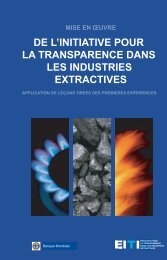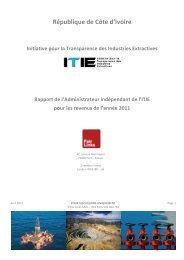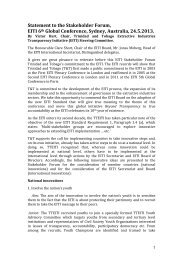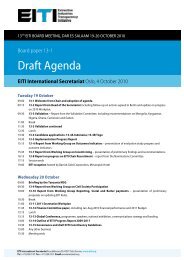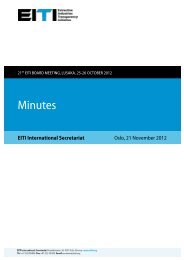Second National Reconcilation Study EITI Peru - unofficial…
Second National Reconcilation Study EITI Peru - unofficial…
Second National Reconcilation Study EITI Peru - unofficial…
Create successful ePaper yourself
Turn your PDF publications into a flip-book with our unique Google optimized e-Paper software.
Consultoría para la Elaboración del Segundo Estudio Nacional de<br />
Conciliación de la Iniciativa de Transparencia para las Industrias<br />
Extractivas (ITIE) en el Perú (2008 – 2010) (continuación)<br />
Ucayali (Canon)<br />
Percentage % Beneficiary<br />
40% Local governments of the department’s district and provincial municipalities<br />
20% Local governments of the municipalities in the province where the resource is<br />
exploited<br />
20% Regional government<br />
10% Local government of the municipality in which the resource is exploited<br />
5% <strong>National</strong> universities<br />
3% Instituto Tecnológicos Nacionales<br />
2% Instituto de Investigación de la Amazonía <strong>Peru</strong>ana<br />
Piura and Tumbes (Canon and sobrecanon)<br />
Percentage % Beneficiary<br />
20% Regional Government<br />
20% District and provincial municipalities where production is located<br />
50% Other district and provincial municipalities in the department<br />
5% Universidad nacional<br />
5% Instituto superiores pedagógicos y tecnológicos<br />
Huánuco - Puerto Inca (Canon)<br />
Percentage % Beneficiary<br />
100% Municipal council of the district of Puerto Inca<br />
2.2.3 Calculating the distribution indices<br />
MEM, through the General Directorate for Hydrocarbons, sends DGDFAS - MEF (formerly DGAES<br />
– MEF) the location of the administrative economic units (oil companies) per District, Province and<br />
Department.<br />
The INEI provides information on the population and Unsatisfied Basic Needs (UBN) per District -<br />
Province – Department.<br />
The DGDFAS - MEF (antes DGAES – MEF) uses the aforementioned elements to determine the<br />
indices of distribution and sends the results to the Secretariat of Decentralization. The distribution<br />
indices are built with the following criteria:<br />
(i) In the case of Tumbes and Piura, the distribution index is built on the foundation of the<br />
equitable provincial distribution index per territory and within the provinces based on a<br />
combination of factors relative to population, poverty, environmental contamination and<br />
basic needs.<br />
(ii) In the case of Loreto and Puerto Inca – Huanuco, the distribution index has been<br />
determined according to the distribution percentages that were established by Law (Art. 8°<br />
de la Ley N° 24300).<br />
Consultoría para la Comisión Multisectorial Permanente de la ITIE Perú<br />
57




